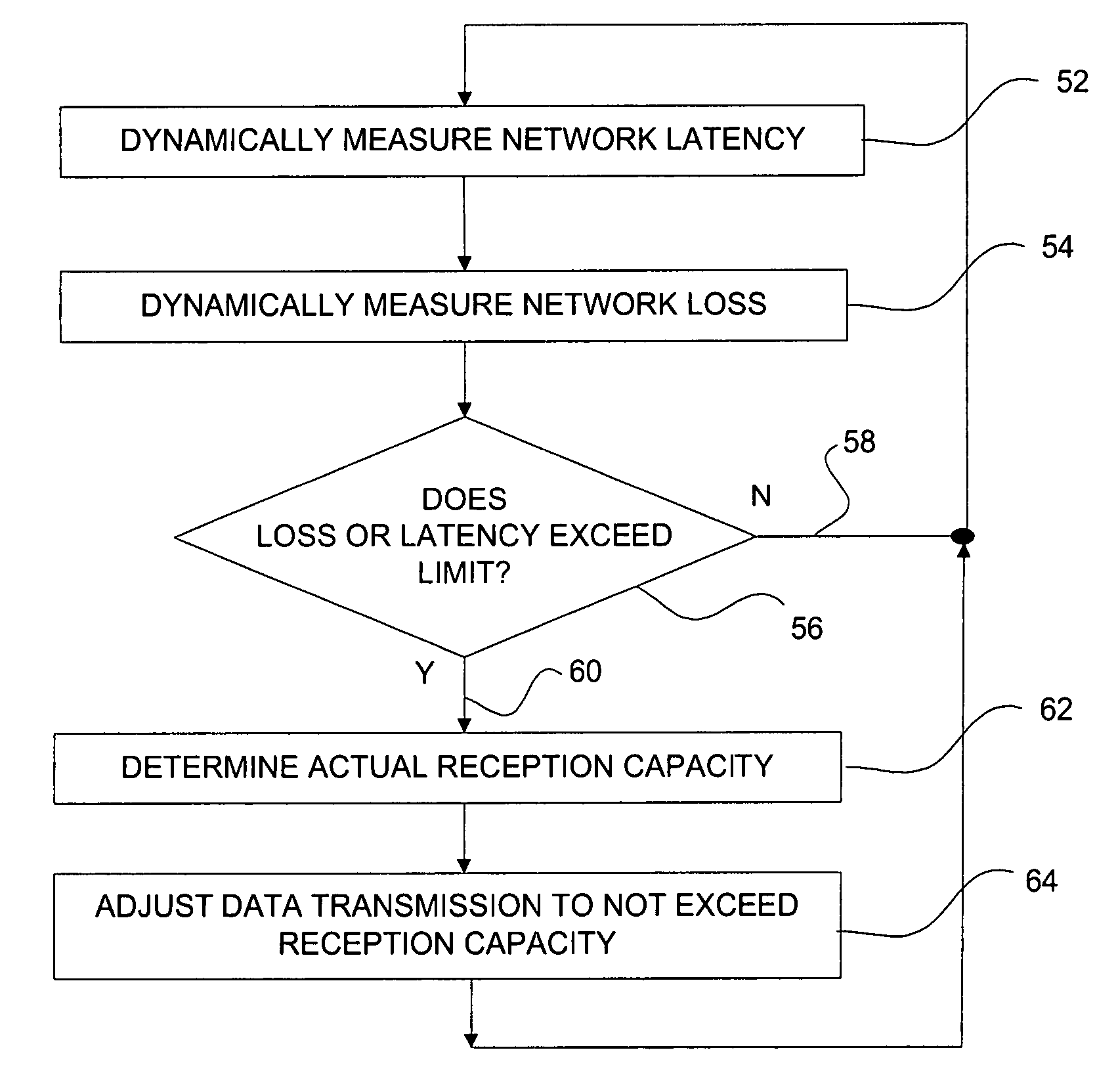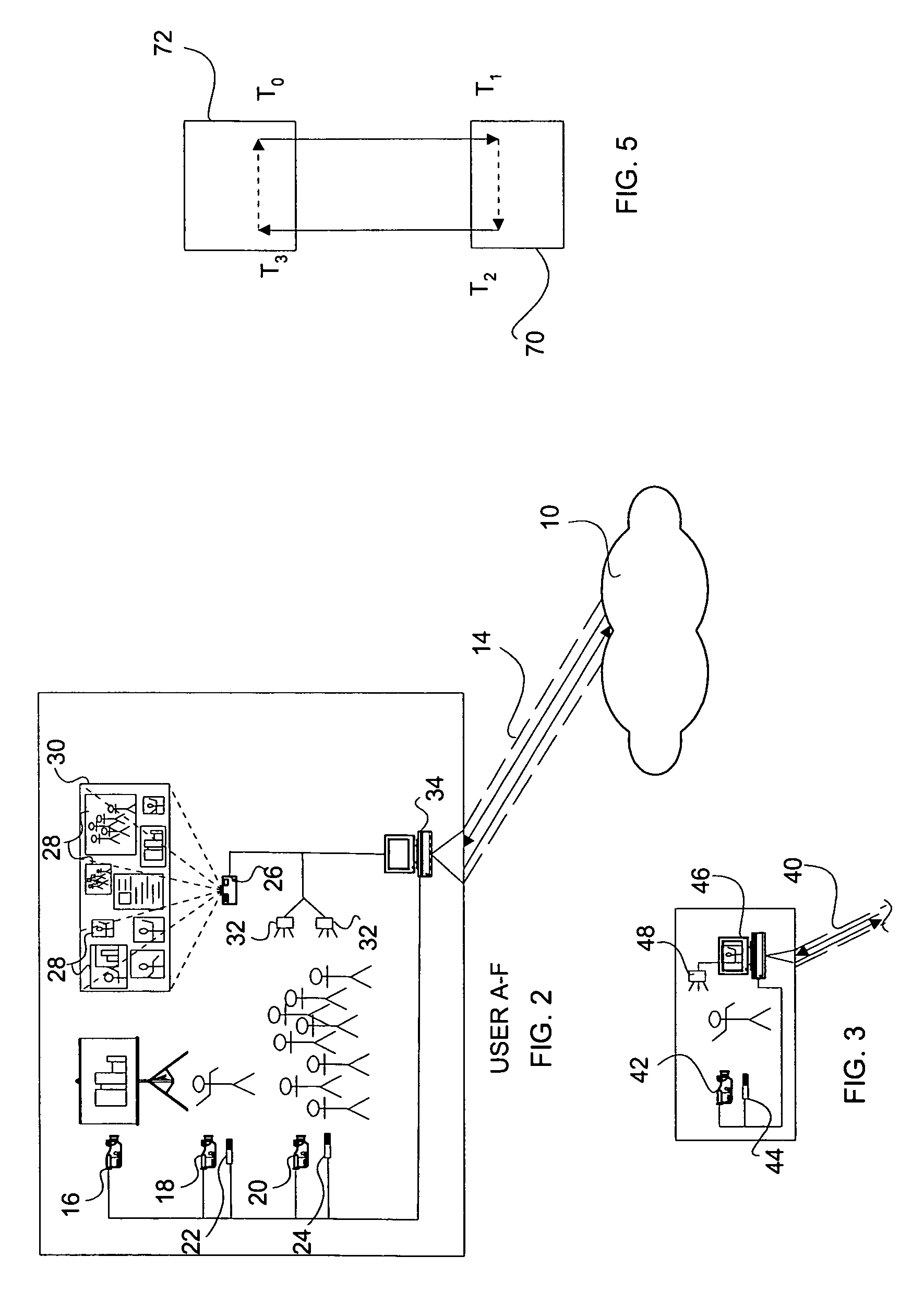Network communications bandwidth control
a network communication and bandwidth control technology, applied in the field of network communication bandwidth control, can solve the problems of data loss in conference or other traffic streams, excessive bandwidth capacity of a particular network connection, and inability to meet the requirements of data transmission, etc., and achieve the effect of reducing the rate of data transmission
- Summary
- Abstract
- Description
- Claims
- Application Information
AI Technical Summary
Benefits of technology
Problems solved by technology
Method used
Image
Examples
example a
“RxCache”
[0104]
/ / Update state info based on a data packet received from this sourceboolSource::DataPacket(const void * packet size_t length, const ntp64_t &rxtime){ const rtp_hdr_t * header = (const rtp_hdr_t *)packet; if (ntohl(header->ssrc) != ssrc_) { return false; / / packet does not pertain to invoking source } uint16_t seq = ntohs(header->seq); / / sequence number uint32_t ts = ntohl(header->ts); / / timestamp if (init_seq_) { / / this is the first data packet we've received from this source / / see RFC 3550 Appendix A.1 for more info on initialization InitSequenceNumber(seq); max_seq— = seq − 1; probation— = MIN_SEQUENTIAL; init_seq— = false; } UpdateSequenceNumber(seq); / / Update interarrival jitter estimation int clockrate = rtp_clockrate(rtp_type_t(header->pt)); if (clockrate != 0) { UpdateTransitTime(((uint64_t(rxtime) * clockrate) >> 32) − ts); } if (max_data_cache— > 0) { / / store this packet's sequence number and recv time record_t value; value.time = rxtime...
example b
“TxCache”
[0105]
/ / Add the number of bytes sent and receivedvoidClient::DataBytesSent(size_t n){(...) if (cache_size— != 0) { / / store the current time, octet count, and packet count record_t record; record.time = ntp64_time( ); record.osent = data_bytes_sent_; record.psent = data_packt_sent_; cache_.push_front(record); / / limit the size of the cache while (!cache_.empty( ) && int((cache_.front( ).timecache_.back( ).time).integer) > int(cache_size_)) { cache_.pop_back( ); } }(...) / / maintain a running average of data packet size avg_pkt_size— −= (int(avg_pkt_size— − n) >> 4); data_bytes_sent— += n; data_packt_sent— += 1;} / / Set the maximum data cache size (in seconds)voidClient::SetCacheSize(size_t seconds){ cache_size— = seconds; while (!cache_.empty( ) && int((cache_.front( ).time −cache_.back( ).time).integer) > int(cache_size_)) { cache_.pop_back( ); }} / / Get the number of packets and octets sent at the given timeboolClient::GetPacketCount(ntp64_t t...
example c
“ClockSync”
[0106]
(...) / / update our round-trip time estimationdelta— = ntp32_t(report.time) − i->lsr − i->dlsr; / / update our clock synchronizationif (report.sender && (!last_sync_time_|| delta_ theta— = uint64_t(report.ntp_ts) − uint64_t(report.time) − uint64_t(delta_) / 2; last_sync_delta— = delta_; last_sync_time— = report.time;}(...) / / Compute the current maximum error in clock synchronizationntp64_tSource::SyncError( ) const{ / / error = + / − [delta + (drift * elapsed)] / / Maximum relative drift -- we're using a very safe value const uint32_t drift = 429497; / / expressed as a 32-bit fraction const uint32_t elapsed = ntp64_time( ) − last_sync_time_; uint32_t max_error = uint32_t(last_sync_delta_) + ((uint64_t(elapsed) * drift) >> 32); return max_error;
PUM
 Login to View More
Login to View More Abstract
Description
Claims
Application Information
 Login to View More
Login to View More - R&D
- Intellectual Property
- Life Sciences
- Materials
- Tech Scout
- Unparalleled Data Quality
- Higher Quality Content
- 60% Fewer Hallucinations
Browse by: Latest US Patents, China's latest patents, Technical Efficacy Thesaurus, Application Domain, Technology Topic, Popular Technical Reports.
© 2025 PatSnap. All rights reserved.Legal|Privacy policy|Modern Slavery Act Transparency Statement|Sitemap|About US| Contact US: help@patsnap.com



